Want to spend two weeks in Japan, but not sure where to go? This Japan 2-week itinerary is just what you need!
Japan is an island nation located in the Pacific Ocean of Asia. It’s characterised by colourful cities, imperial palaces, ancient temples, and peaceful landscapes.
There are so many fascinating aspects of Japanese culture. For this reason, this is a country you’ll want to explore as much as possible when you visit.
Although two weeks in Japan isn’t nearly enough time to discover the whole country, it’s a great start. To help you manage your time, I’ve put together this 14-day Japan itinerary.
I included a great combination of famous Japan bucket list spots, but also some hidden gems, as well as some helpful logistics advice and travel essentials.
As someone who grew up watching Japanese cartoons and practicing Judo, one of the most popular sports in Japan, I was absolutely stoked to finally visit.
I had an incredible two weeks in Japan, and I hope you find this itinerary useful in planning your own time there! So here it is, the best way to see the glory of Japan in 2 weeks!
Contents
- 1 How to travel around Japan
- 2 How to spend 2 weeks in Japan
- 2.1 Day 1: Arrive in Tokyo
- 2.2 Day 2: Day trip to Kamakura
- 2.3 Day 3: Exploring Tokyo
- 2.4 Day 4: Travel to Kyoto
- 2.5 Day 5: Fushimi Inari Taisha Temple in Kyoto
- 2.6 Day 6: More Kyoto temple exploring
- 2.7 Day 7: Travel to Hiroshima
- 2.8 Day 8: Ferry to Miyajima Island
- 2.9 Day 9: Travel to Osaka
- 2.10 Day 10: Day trip to Nara
- 2.11 Day 11: Explore Osaka
- 2.12 Day 12: Travel back to Tokyo
- 2.13 Day 13: Tokyo
- 2.14 Day 14: Tokyo & end of trip

The pagoda of Hokanji temple at sunset
How to travel around Japan
The easiest way to get around Japan is by train and public transport.
Japanese trains and public transport are well known for their efficiency and punctuality, and exploring Japan with them not only will be the easiest and most cost effective way, but it will also provide you with a genuine Japanese experience.
If you’re going to travel a lot around Japan (as you will if you follow this Japan 2-week itinerary) you’ll want to purchase a Japan Rail Pass.
This is basically the equivalent of the European Interrail Pass and allows you hop on and off as many trains as you want in Japan, within your chosen time period (7, 14 or 21 days).
With a Japan Rail Pass you don’t have to prebook trains beforehand, there are carriages for with non reserved seats.
However if you’re travelling in a group and want to be sure to sit together you should reserve seats. Reserving seats is free, and you can do it at any Japan Rail office in any train station.
Click here to purchase your Japan Rail Pass!
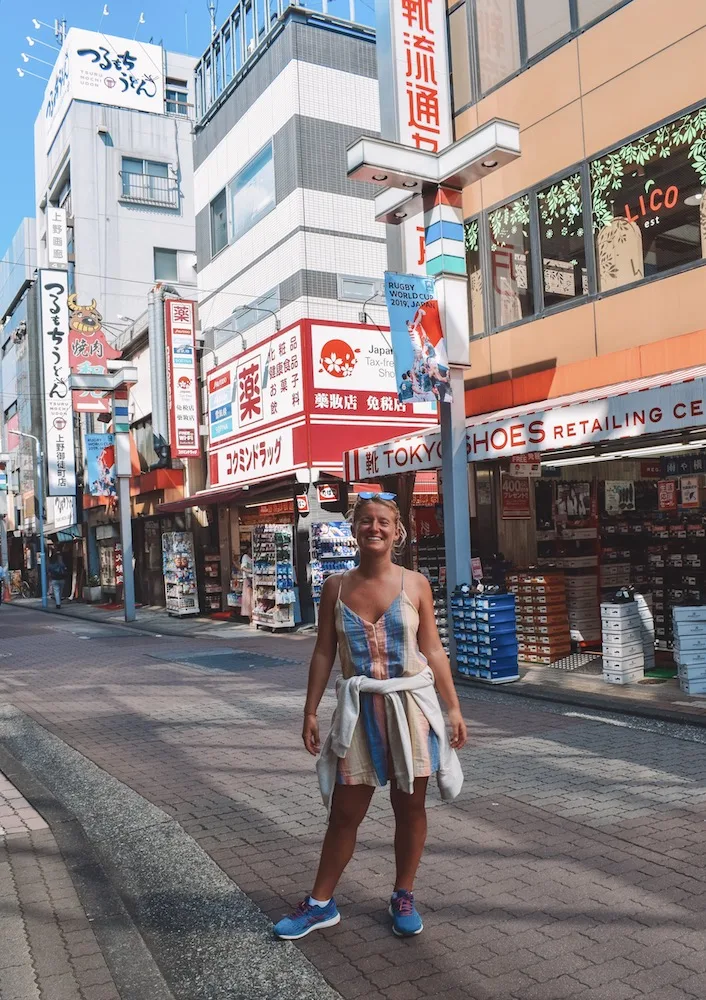
Exploring Ameyoko in Tokyo
The Japan Rail Pass will cover your long distance journeys between cities. Within cities, you will want to use public transport. Public transport is super efficient and you can easily plan your journeys with Google Maps.
Google Maps in Japan is perfectly integrated, and will display the exact train and / or bus departure times and total journey times.
I was amazed to find that it would even tell you what station entrance to go in from to be closer to your platform, the platform of your train, what carriage to choose to then be closest to your exit, and the station exit that would then be closest to your final destination.
It was a map heaven for a geographer like me! The Japan Rail Pass won’t cover public transport within cities, but you can easily either pay for the individual fares or get a daily ticket at any train station.
| READ MORE: IS THE JAPAN RAIL PASS WORTH IT? |
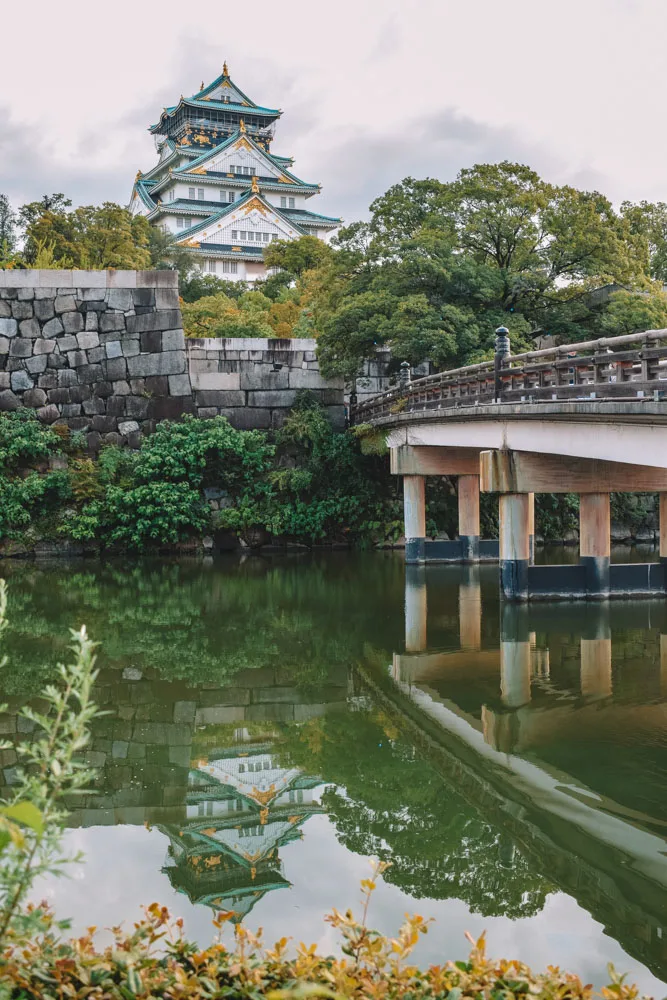
Reflections at Osaka Castle
How to spend 2 weeks in Japan
Day 1: Arrive in Tokyo
Tokyo is the perfect place to start your two weeks in Japan. It’s the capital of the country and full of energy.
It’s full of traditional temples, shrines, renowned museums, galleries and peaceful zen gardens. It has the perfect mix of old and new.
After arriving, you’ll probably want to take it a little easy after your long flight. I checked into the Sunshine City Prince Hotel in Toshima City.
This area is a bit out of the tourist crowds, but very well connected to all the attractions. It’s a great place to really soak in authentic Japanese culture, but you won’t feel overwhelmed by the rush of the big city.
Click here to book your accommodation at the Sunshine City Prince Hotel

The view from my window at the Sunshine City Prince Hotel in Toshima City
After you’ve recharged a bit, head to Shinjuku to explore the nightlife. It’s only 15 minutes away from Toshima City, using public transportation.
Golden Gai is a pretty awesome area to check out in Shinjuku. It’s full of narrow alleys with lots of small bars. It’s a quirky and interesting place to add to your Japan itinerary.
You can also take a Shinjuku night walking tour, which will really help familiarize you with the area.
Click here to go on a Shinjuku night walking tour in Japan
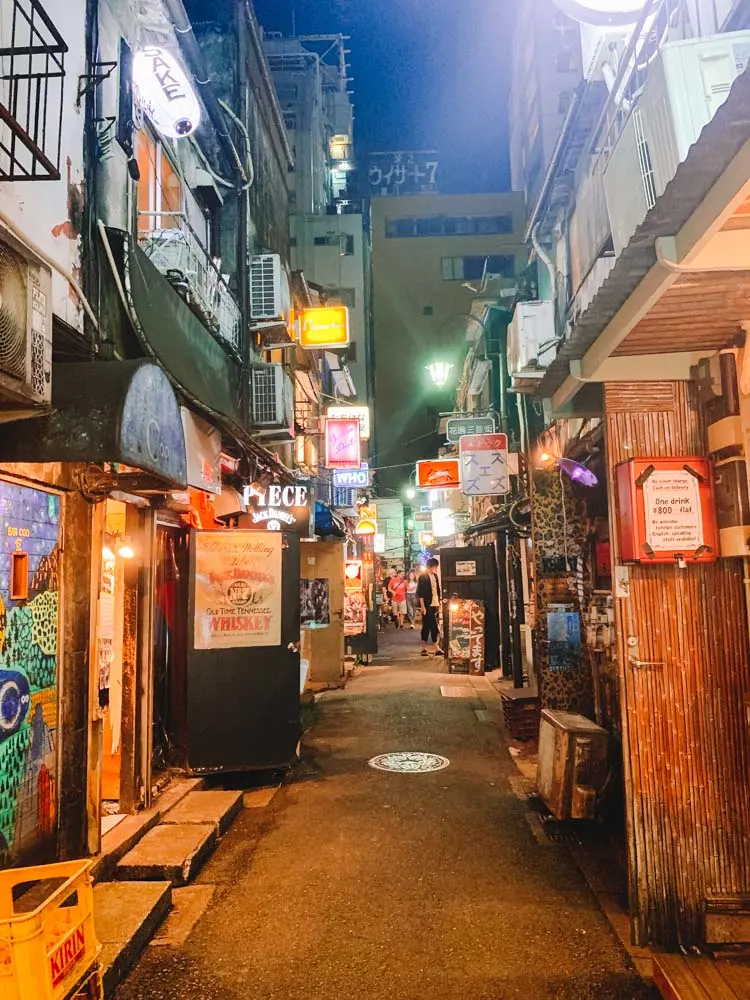
The streets and bars of Golden Gai in Shinjuku at night
Day 2: Day trip to Kamakura
On the second day of your Japan travel itinerary, take a day trip to Kamakura. This coastal city is famous for its temples and shrines. And it’s also conveniently situated only one hour from Tokyo.
Take the train from Tokyo to Kamakura station and make your first stop at the Engakuji Temple. This is one of the most important Zen Buddhist temples in Japan.
It’s an impressive complex with multiple shrines and a very peaceful atmosphere.
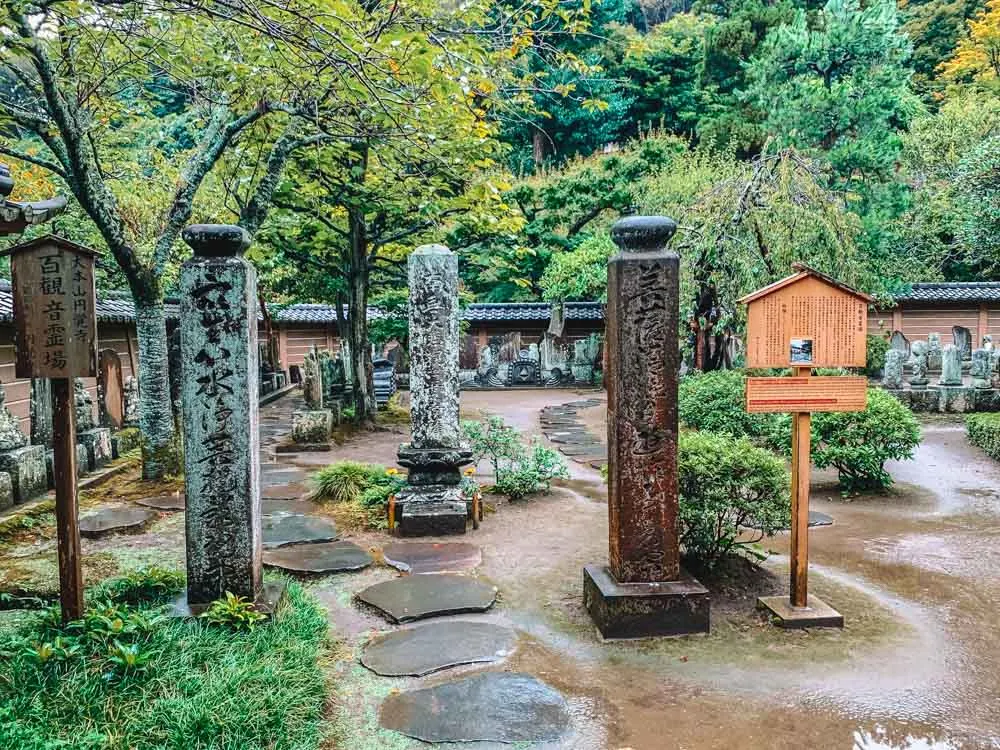
Exploring Engakuji temple close to Kamakura
After you’ve finished exploring, hop back on the Japan Rail and head to Komachi Street.
This area is loaded with lots of cool shops and street food options. Take some time to wander around, do a bit of shopping, and indulge in the local flavours of Kamakura.
Komachi street leads to Tsurugaoka Hachiman-gu temple. The building is very integrated with the landscape. If you’re lucky, you might be able to witness an actual ritual taking place while you’re there.
| READ MORE: THE ULTIMATE DAY TRIP TO KAMAKURA FROM TOKYO |
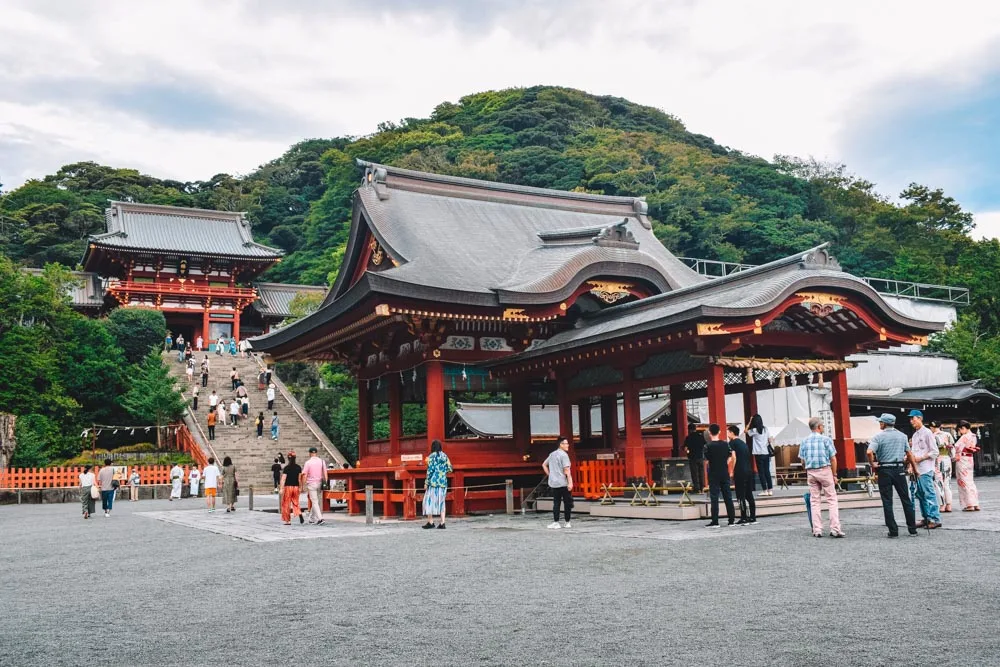
Arriving at Tsurugaoka Hachiman-gu Temple in Kamakura
Next, you should visit Kotoku-in (the big Buddha of Kamakura). You can get there easily from the Kamakura train station by bus, which should only take 10-15 minutes.
This imposing bronze statue is of Amida Buddha – one of the most famous icons of Japan. This Buddha is beautiful and you really do feel a sense of tranquillity around it.
If all this hopping on trains and buses sounds stressful, worry not, as you can also visit Kamakura on an organised day tour from Tokyo. That way you won’t have to worry about planning any logistics, and will have a local guide with you to tell you about the history of the amazing sights you’ll visit.
Click here to book your day trip to Kamakura from Tokyo!

The famous big buddha of Kamakura in Japan
Day 3: Exploring Tokyo
During your first full day in Tokyo, check out some of Tokyo’s unique neighbourhoods. You can start the day by spending some more time in Shinjuku, this time by day.
The Metropolitan Government building is a must-see. There’s an observation room at the top that’s open to the public. You’ll have a complete view of the Tokyo skyline for free!
Next up, visit the Shibuya neighbourhood. This is one of Tokyo’s fashion centres. It’s a colourful district filled with lots of unique stores.
The Harajuku neighbourhood of Shibuya is famous for its ever-changing fashion scene and colourful street art. Visit Takeshita Street and check out some vintage clothing stores and cosplay shops.
Or, if you prefer shopping at high-end boutiques, Omotesando Avenue is the place for you. If you’re looking to pick up a few new clothing items during your Japan trip, this is the area to shop in.
| READ MORE: HOW TO SPEND 5 DAYS IN TOKYO |

Takeshita street in Harajuku
The Shibuya neighbourhood is also famous for the iconic Shibuya crossing; which some people call the busiest road intersection in the world.
For the best view of Shibuya crossing go either to the second floor of the Starbucks just across it, or to the top floor of any of the buildings that surround it.
Shibuya is also home to the statue of Hachiko, the famous dog whose life inspired the movie “Hachi: A Dog’s Tale”. You will find it just outside the Shibuya station.
Basically there are lots of amazing corners and neighbourhoods in Tokyo. It would take weeks to properly discover them all, but since you only have two weeks for the whole of Japan, you need to wrap up your Tokyo sightseeing quickly.
One great way to do so is to join a Tokyo sightseeing tour. That way you’ll have local guides sharing interesting insights with you, as well as handling the complicated transport situation. I listed below some of the most popular tours online.
Tokyo: Ueno Private Walking Tour with Shrine Visit – Discover the famous neighbourhood of Ueno on a private walking tour, including Toshogu Shrine, Ameyoko and Ueno Park.
Tokyo: Shinjuku Drinks and Neon Nights Nightlife Tour – This evening tour is the perfect way to discover Shinkuju like a local, and taste some delicious Japanese treats along the way!
Shinjuku: Private Guided Tour of Shinjuku’s Top Sights – If you prefer to discover Shinjuku by day, this private tour will take you to Golden Gai, the Samurai Museum and many other key sights in this neighbourhood!
Shibuya & Harajuku: Hidden Gems & Highlights Private Tour – Accompanied by a local guide, this private tour will take you to all the must-see spots of Shibuya & Harajuku, as well as including some drinks and food!
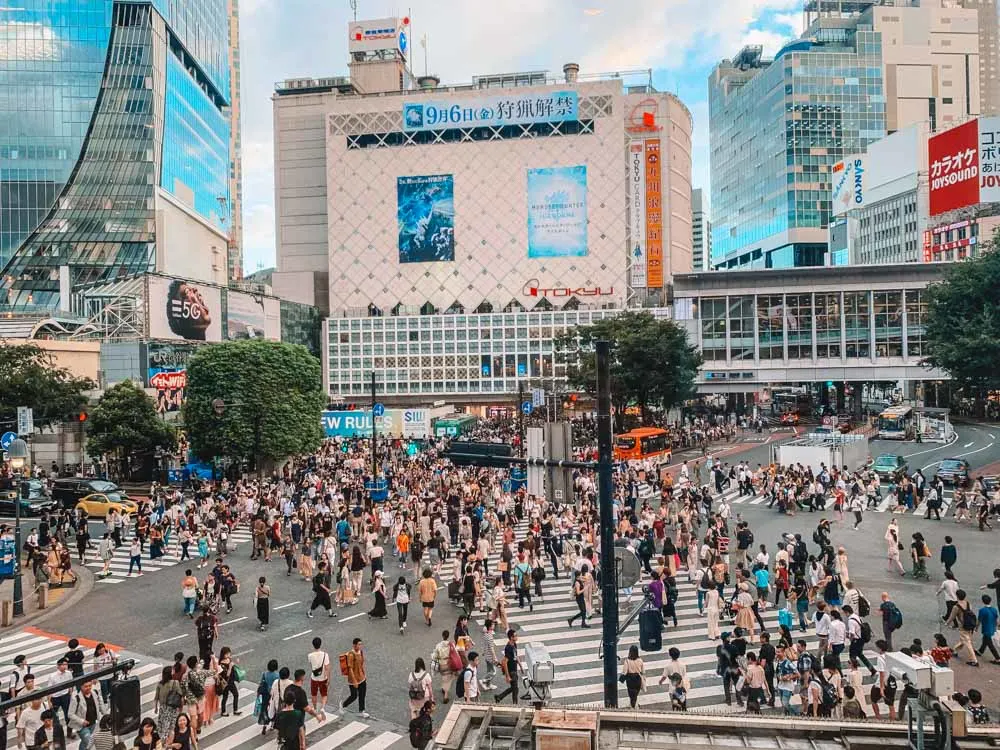
Shibuya crossing seen from the top floor of Starbucks in Tokyo
Day 4: Travel to Kyoto
After a few days in Tokyo, it’s a good idea to head out and discover more of the country. If you’re only spending two weeks in Japan, there’s a lot more you’ll want to see.
Take the morning train to Kyoto. It’s about a 2-hour and 40-minute journey from Tokyo using the Japan Rail (JR) so try and get an early start.
When you arrive, make your way to the Kiyomizu-Dera temple. The temple was founded in 778 and is famous for its large wooden terrace.
This outdoor platform juts out over the hillside and offers picturesque views of Kyoto. If you want to properly understand the history and culture of this temple, you can join a Kiyomizu-Dera temple guided tour.
Click here to book your Kiyomizu-Dera temple guided tour!
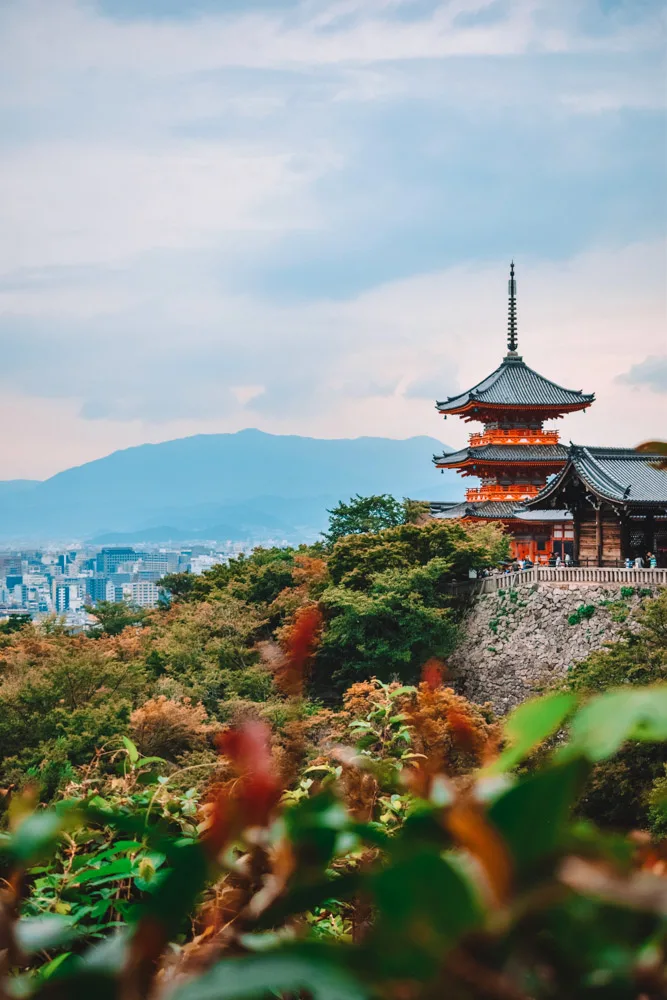
The view from Kiyomizudera temple over its main pagoda with Kyoto in the background
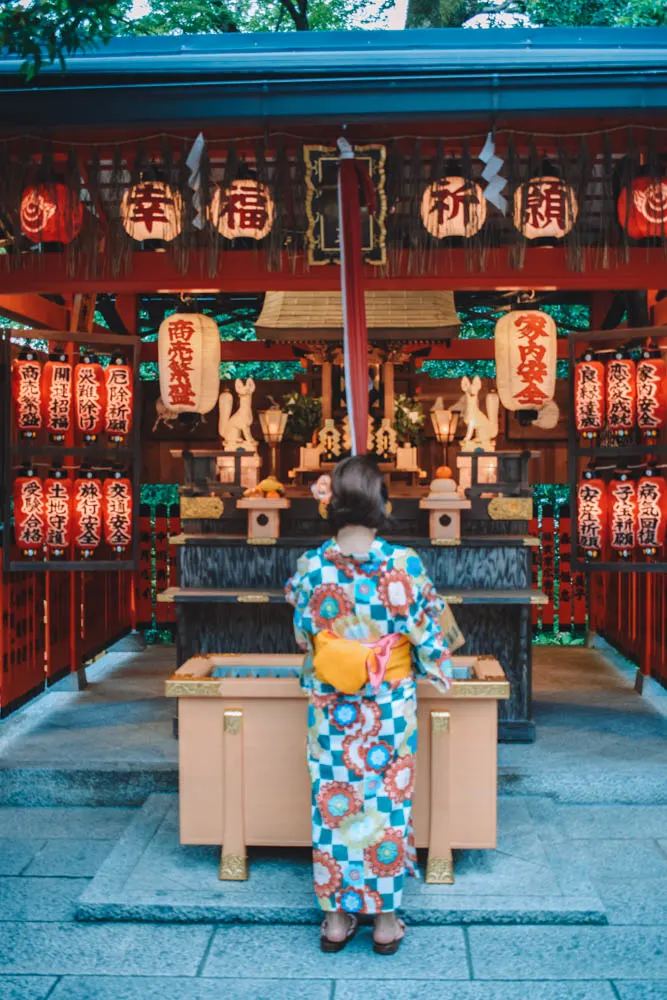
Paying homage at Kiyomizudera temple in Kyoto
When you’ve finished at the temple, take some time to explore the surrounding area. The nearby Gion neighbourhood lies at the heart of Kyoto and is known as the geisha district.
It’s packed with bars, restaurants, and traditional teahouses, You can book a walking tour and explore the culture of this historic city.
For a stunning sunset, make your way to the Hokanji Temple pagoda. This 5-story Buddhist pagoda temple offers panoramic views from the top. It’s the perfect place to watch the sun slowly fade away into the night.
Click here to book a Gion neighbourhood walking tour!
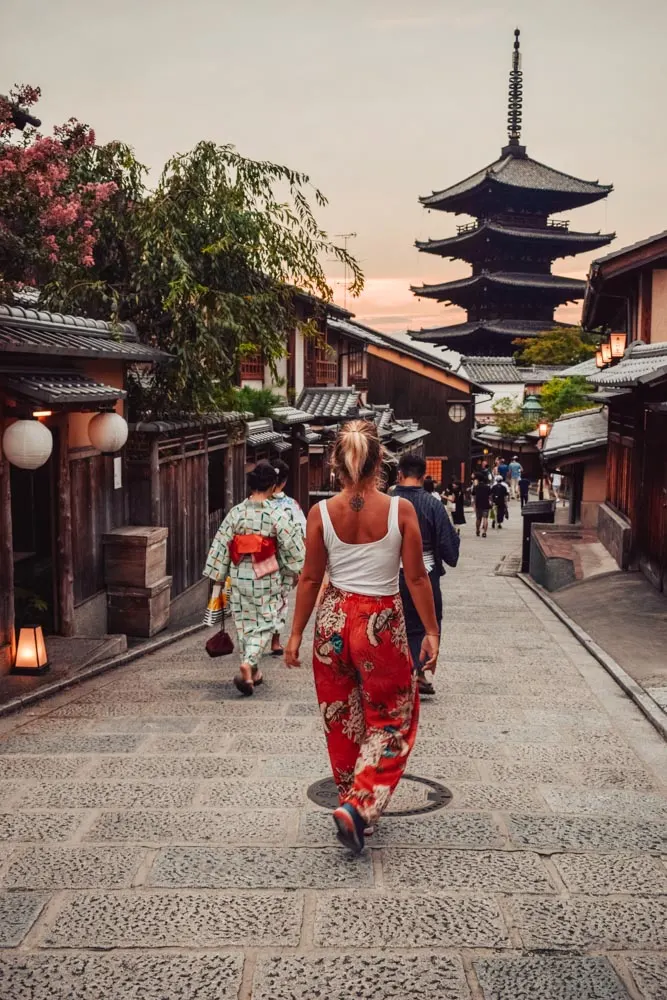
Wandering the streets of Kyoto under the distinctive Hokanji temple pagoda
After sunset, head over to Pontocho alley for dinner. This is a pedestrian street full of cosy restaurants.
It’s considered the most beautiful street in the city. Whether you’re looking for traditional, or western-style food and drink options, you’ll find it all here.
In Kyoto I stayed at Hotel Elcient Kyoto.
While it’s not particularly close to any of the main attractions, it’s very conveniently located just across the road from Kyoto main station, which makes it well connected to everything you want to see in Kyoto.
Click here to book your stay at Hotel Elcient Kyoto!
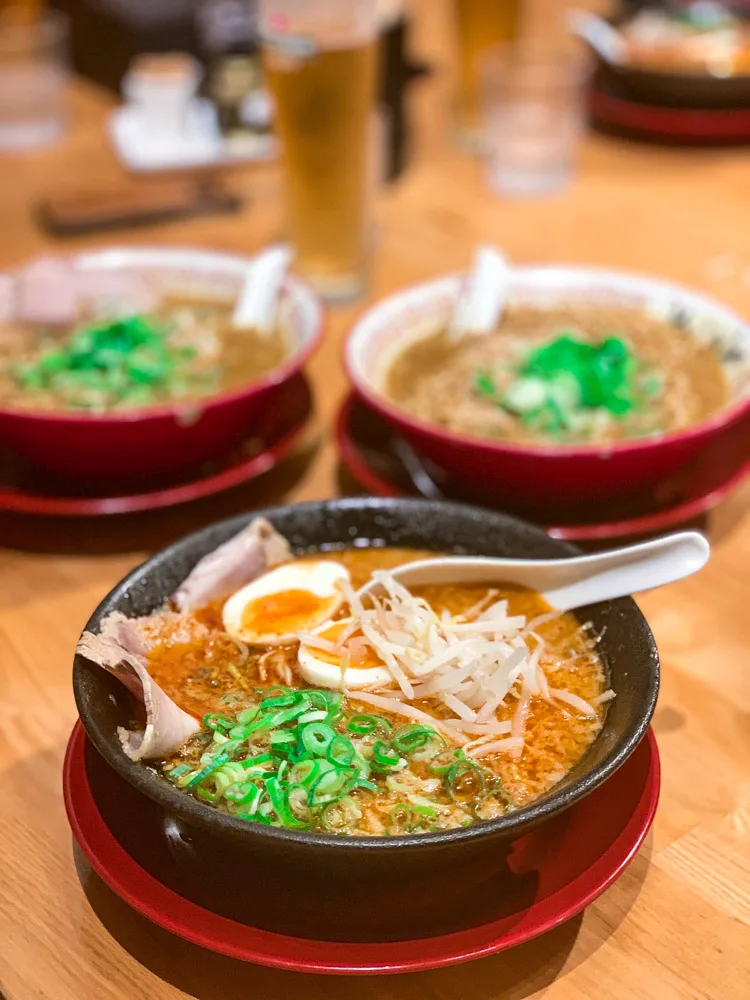
Enjoying ramen dishes in Kyoto
Day 5: Fushimi Inari Taisha Temple in Kyoto
Start day 5 of your Japan trip itinerary with an early morning hike.
There’s really no better way to appreciate the natural beauty of Japan than immersing yourself in nature. Plus, getting an early start means there will be fewer crowds.
Fushimi Inari Taisha temple is an important Shinto shrine. There’s a path with over 5000 colourful orange torii gates that wind through the hills behind the shrine.
Hiking this area is one of the most rewarding activities you’ll complete during your 2 weeks in Japan. The journey up to the summit of the mountain and back takes about 2-3 hours.
The beginning of the torii gate path is super crowded. It gets less busy and more scenic as you travel up.
Along the way, there are a few restaurants and places to buy water and snacks. At the top, you’ll be greeted with an incredible, sweeping view of Kyoto.
If you want to discover this iconic Japan bucket list sight with a knowledgeable local guide, you can join a small group cultural walking tour.
Click here to book your Kyoto small group tour to Fushimi Inari Taisha and other key sights!
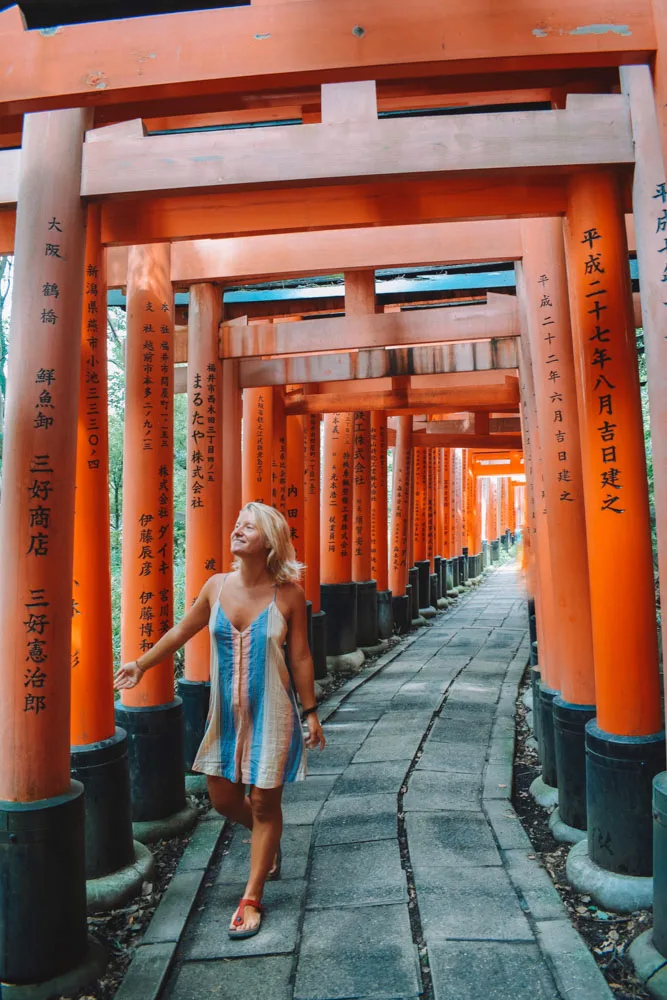
Wandering through the famous red torii gates of Fushimi Inari Taisha in Kyoto
Afterwards, enjoy a meal at the Nishiki market in downtown Kyoto. You’ll find so many good food choices, including lots of amazing Japanese delicacies at very reasonable prices.
Nishiki market is one of the main spots to visit in Kyoto, where you can not only taste amazing Japanese street food, but also shop for souvenirs and kimonos.
Discovering the narrow streets of this market was one of my favourite activities of my two weeks in Japan. If you want to make sure you eat at all the best stalls, you can join this Nishiki Market food tour!
Click here to see prices & availabilities for a Kyoto Nishiki Market food tour!
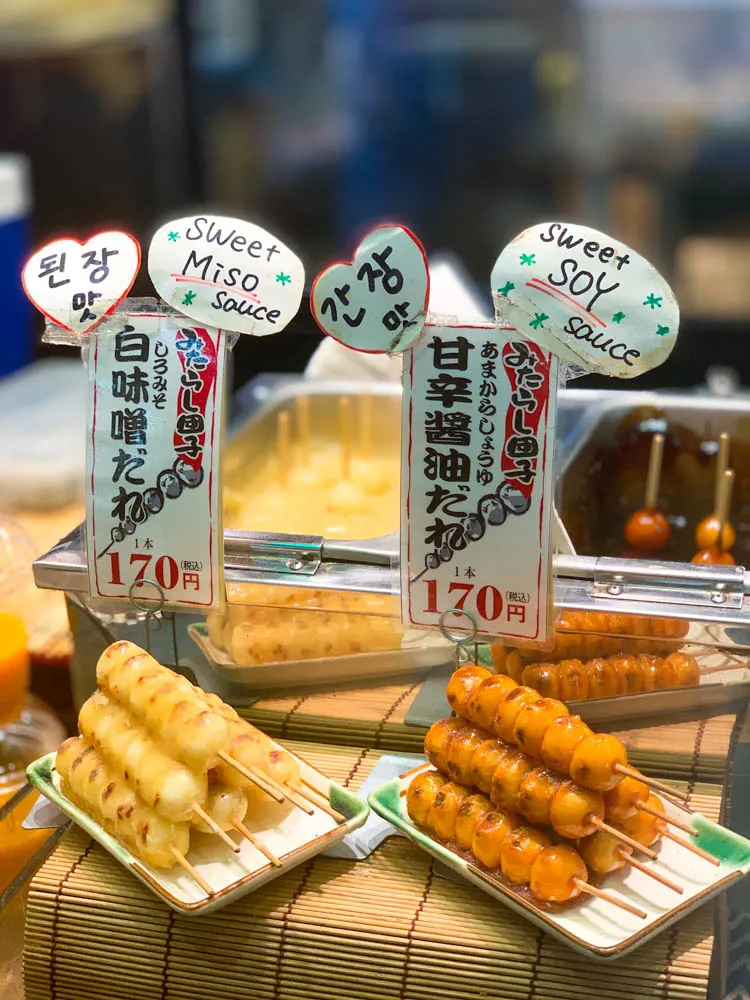
Dango skewers at Nishiki market in Kyoto – they soon became my favourite dessert in Japan!
Day 6: More Kyoto temple exploring
On your final day in Kyoto, spend some time in the Arashiyama district – on the outskirts of Kyoto. From Kyoto Station, take the Japan Rail Sagano lines to Saga-Arashiyama Station. The train ride takes about 20 minutes.
When you arrive, the Arashiyama Bamboo Forest should be your first stop.
The forest gets very crowded later on in the day, so it’s best to get there early in the morning. The forest is open 24/7, so you can arrive as early as you’d like.
Stroll the paths lined with endless rows of towering bamboo that stretch up to the sky. There’s really nothing quite like it. In my opinion, seeing a bamboo forest should be included in all Japan travel itineraries.
| READ MORE: AN EPIC KYOTO 3-DAY ITINERARY |
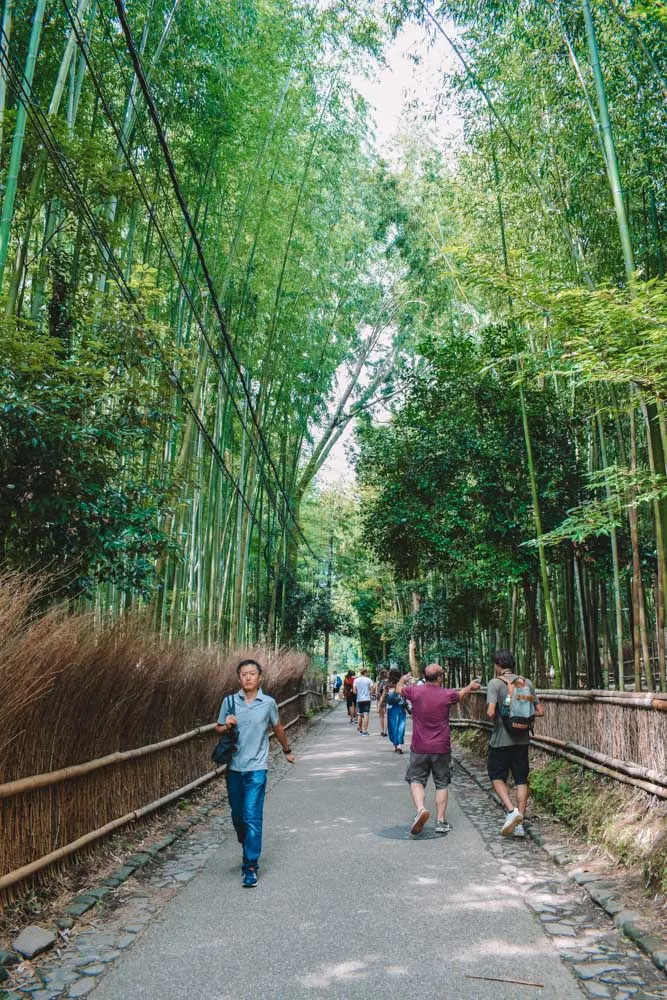
Arashiyama bamboo grove in Kyoto
Next, you should visit Arashiyama Monkey Park. As the name suggests, this park is famous for its monkey population. Over 170 Japanese macaque monkeys inhabit the area.
You’ll be able to see these animals up close and even feed them in a designated area. The park also offers beautiful views over Kyoto.
Personally we just wandered around Arashiyama alone, but if you prefer to have a local guide give you tips and insights, make sure to join this bamboo grove & temple tour!
Click here to book your Arashiyama bamboo grove & temple tour in Kyoto!
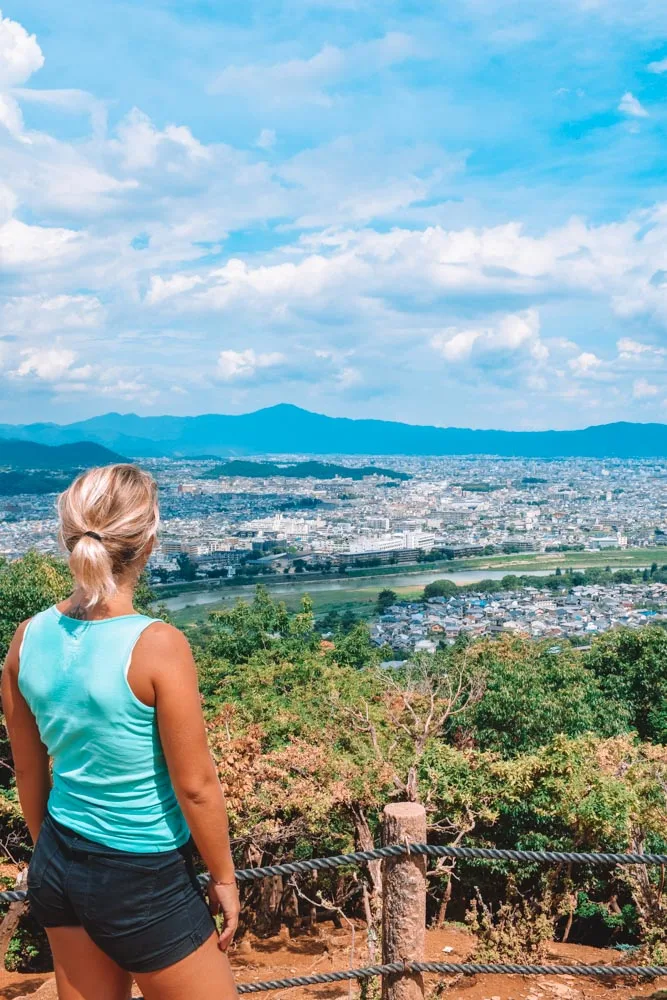
Enjoying the view over Kyoto from the top of Arashiyama Monkey Park
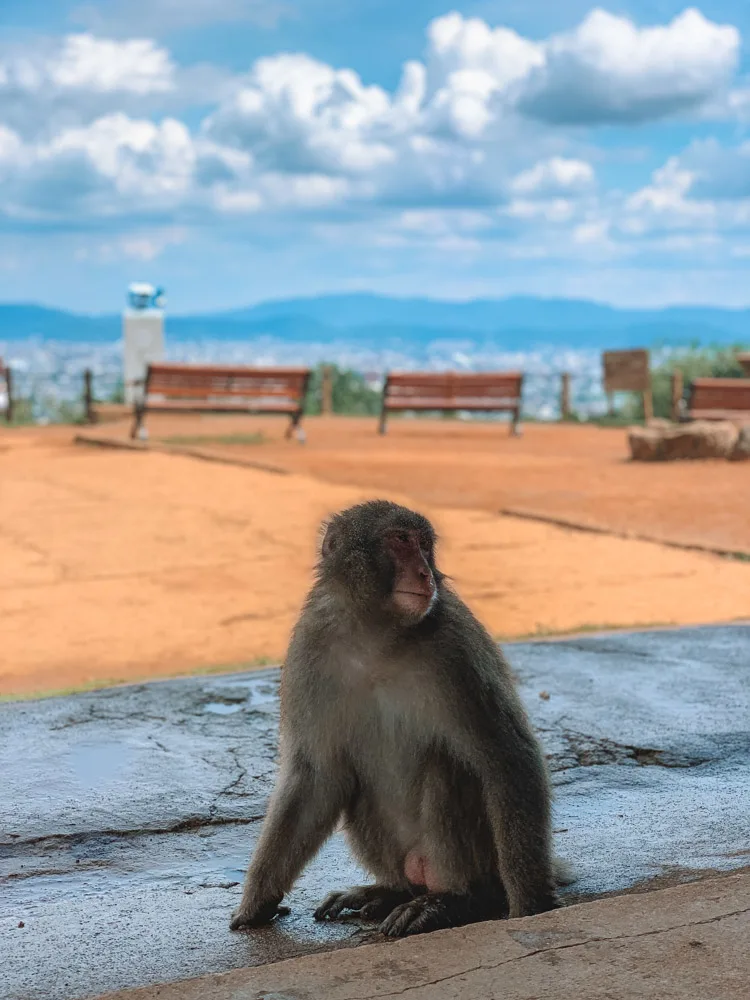
A monkey in the Arashiyama Monkey Park in Kyoto
Lastly, you should check out the Kinkaku-ji Golden temple. This beautiful gold temple is surrounded by peaceful gardens and set next to a quiet pond.
It has an enchanting appeal, especially when the golden walls shine in the sunlight.
While you’re in the area you should consider riding the famous Sagano Romantic Train. This train ride will take you through what is considered one of the most beautiful railway journeys in Japan.
Book your romantic Sagano train ride here!
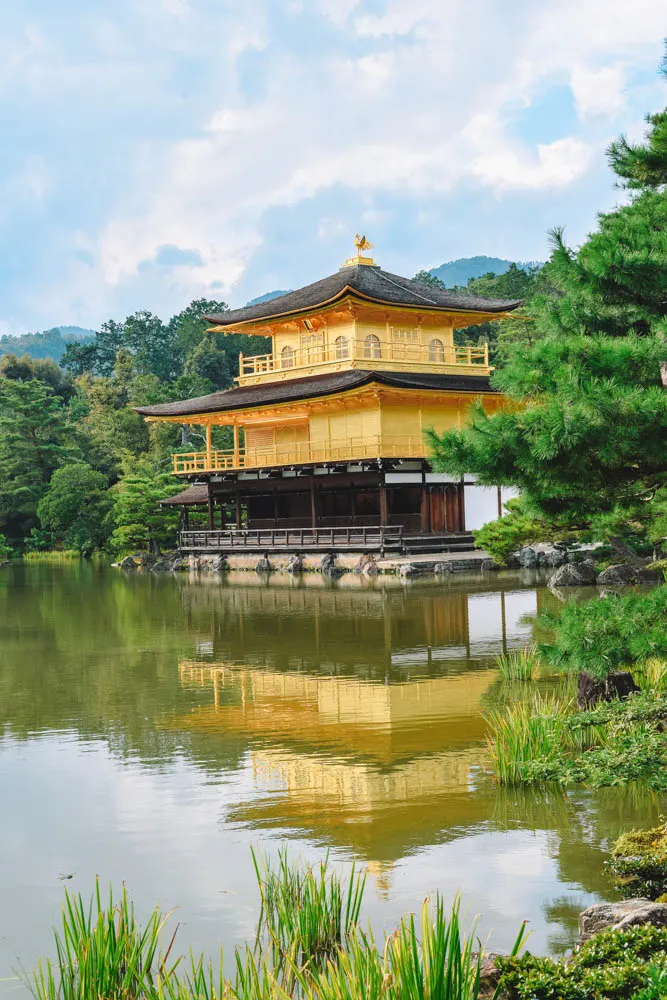
The Kinkaku-ji golden temple in Kyoto
Day 7: Travel to Hiroshima
Now that you’re halfway through your two-week Japan itinerary, it’s time to head even further east, to Hiroshima and Miyajima. It takes around 2.5 hours on the Japan Rail to get to Hiroshima from Kyoto.
First, visit the Hiroshima Peace Memorial Park. This area serves as a memorial to the people who were killed in the atomic bombing of Hiroshima, on 6 August 1945.
There are three different areas you’ll want to visit: The Atomic Bomb Dome, The Hiroshima Peace Museum, and the Peace Memorial Park.
The whole area is dedicated to documenting the atomic bombing that was dropped on Hiroshima in World War II.
You’ll want to spend at least a few hours walking around and educating yourself on this tragic, yet important, part of history. I found some of it quite tough to look at, and was surprised at seeing young children there on school trip.
The Hiroshima Peace Memorial is an example of a dark tourism site; a place where horrible things have happened, but it’s important we visit it, so as to never forget and learn from the past.
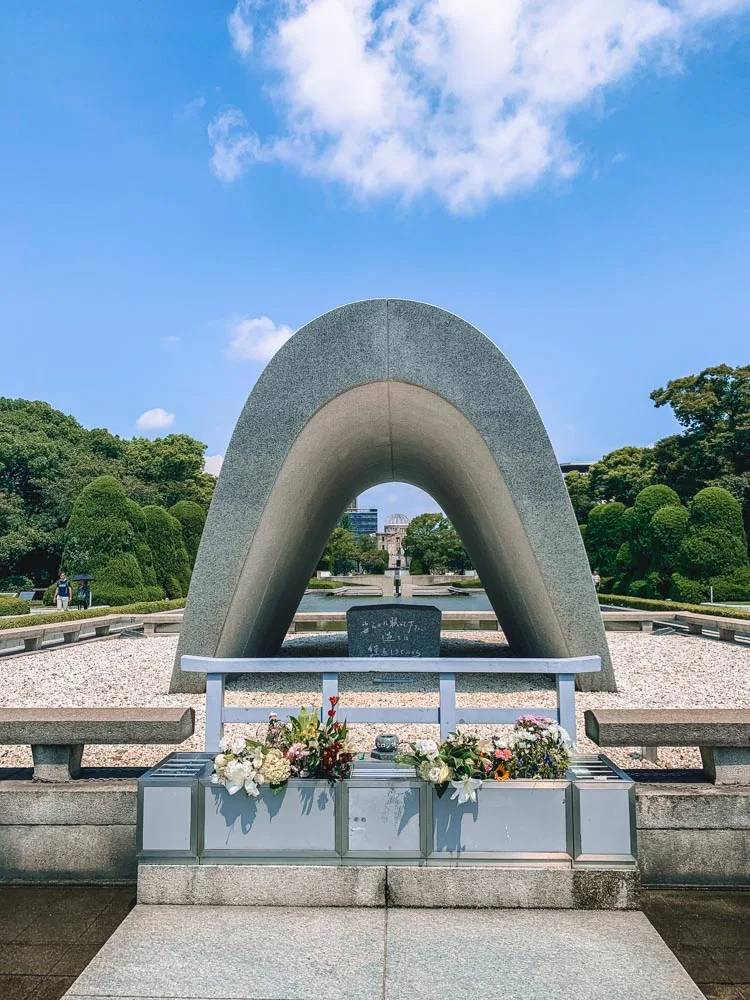
Hiroshima Peace Memorial
Next, visit Hiroshima castle. The castle was constructed in the 1590s but was unfortunately destroyed by the atomic bomb in 1945.
It was rebuilt in 1958. It’s a replica of the original and houses a museum that showcases Hiroshima’s history.
The castle also gives guests the opportunity to dress up in period outfits, including Samurai armour. This is a great stop on your Japan tour itinerary to learn about the history of the country in relation to WWII.
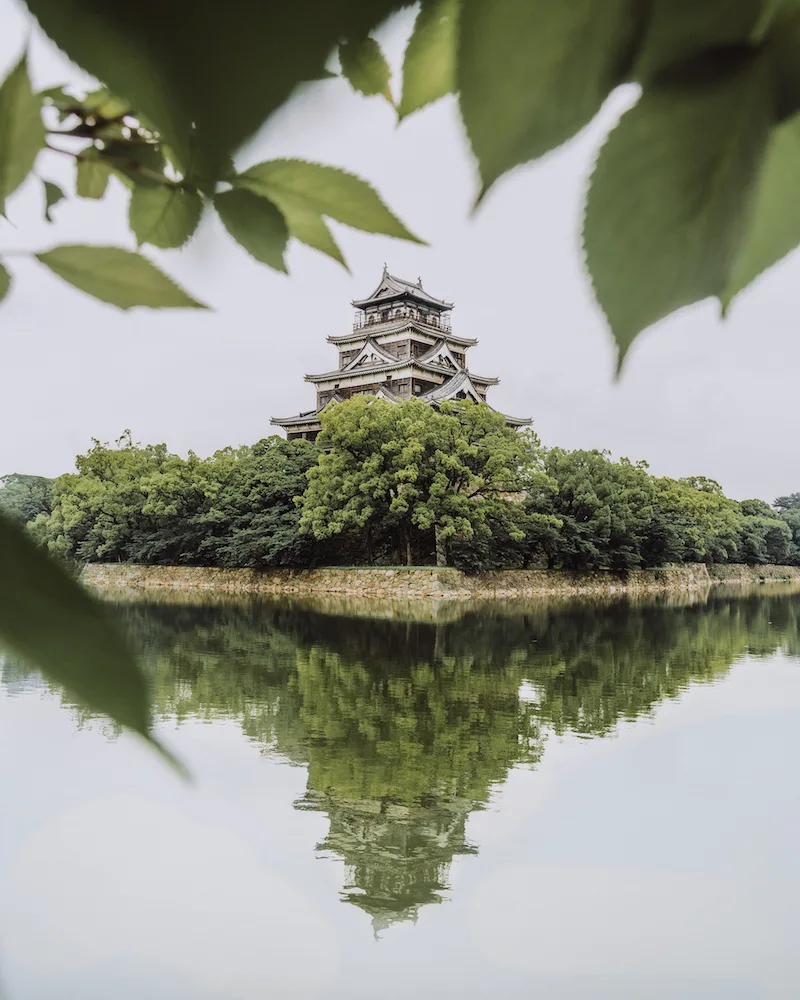
Hiroshima Castle – Photo by Tom Shu on Scopio
Day 8: Ferry to Miyajima Island
After enjoying a wonderful day in Hiroshima, visit the small island of Miyajima. The island is known for its forests, ancient temples, and fresh oysters – which are very popular at the street food market.
Miyajima Island is located just a quick 10-minutes from Hiroshima Bay. This ferry trip is free with your Japan Rail Pass.
For a great exercise with rewarding views, make hiking up Mount Misen your first activity. This sacred mountain is the highest mountain on the island.
It’s a steep hike up, but you can take the cable car up part of the way up and then hike down. You’ll have epic views of the islands and coast of mainland Japan from the top.
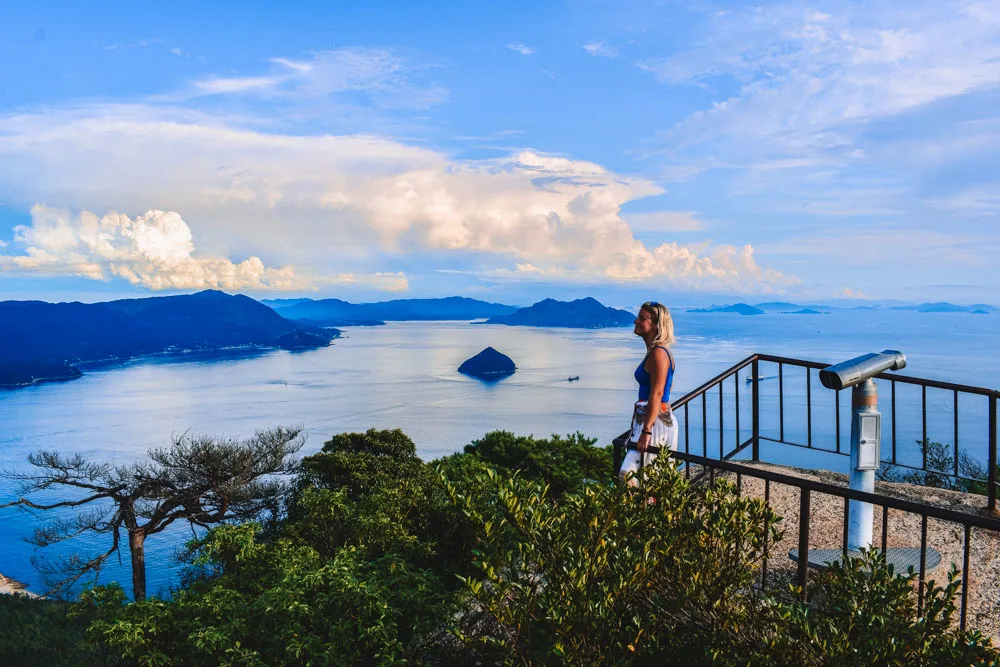
The view from the peak of Mount Misen in Miyajima Island
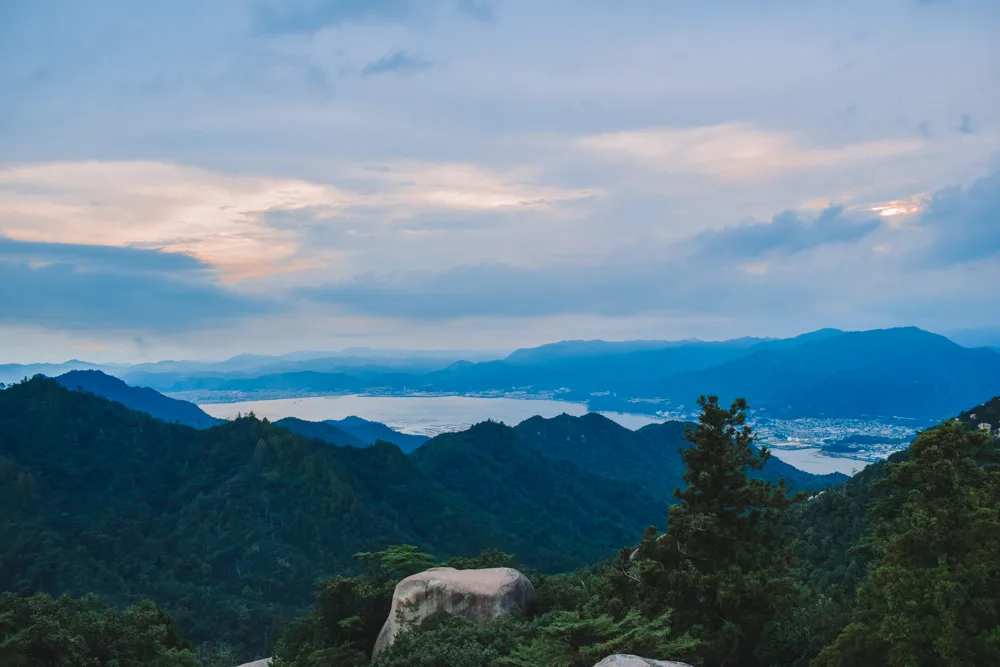
The view from the peak of Mount Misen in Miyajima Island
While you’re on Mount Misen, visit the Daishoin temple. This temple complex is spread on a slope of the mountain and features over 500 statues of varying shapes and sizes.
Next, visit the Itsukushima Shrine. The shrine and its torii gate are built over water and made to look like they’re floating in the sea during high tide.
At the time of my visit (September 2019) unfortunately it was undergoind construction, and they haven’t really said when it will end.
| READ MORE: HOW TO SPEND ONE DAY IN MIYAJIMA |
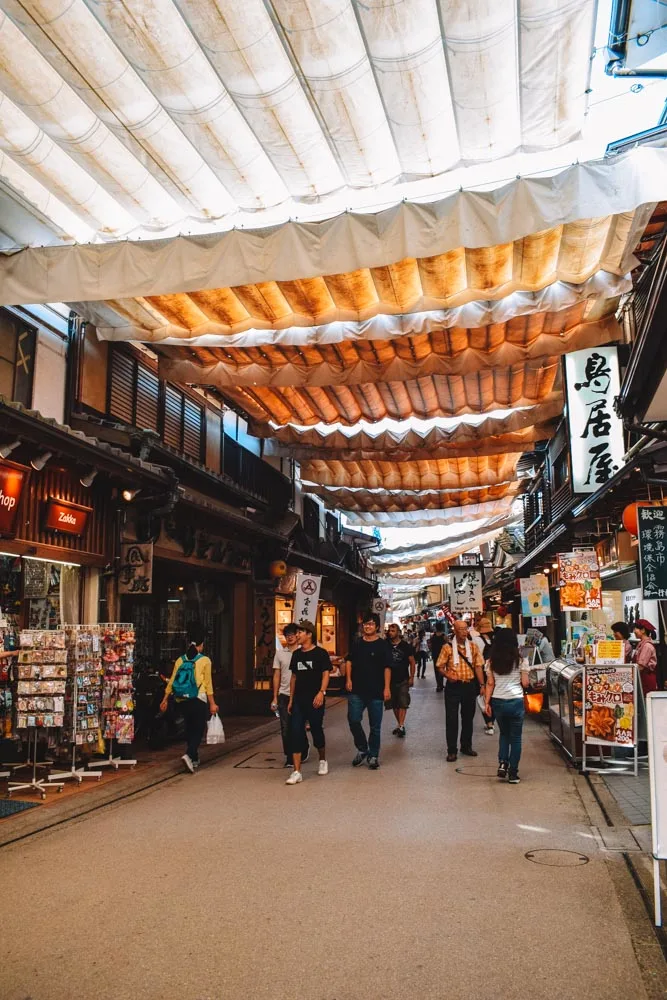
The cute market streets on Miyajima Island
The five-story pagoda on the island is a must-visit too, especially for photo lovers. It’s beautiful, peaceful, and breathtaking – another one of the many treasures found on Miyajima Island.
If you want to add a really cool cultural experience to your itinerary for Japan, spend the night in a ryokan. This is a type of traditional Japanese accommodation.
If you use AirBnb in Japan you can usually find both ryokans and normal apartment style accommodation. I stayed at the Miyajima Hotel Makoto, which is located on the island, just a 5-minute walk from Miyajima Pier.
Click here to book your stay at the Miyajima Hotel Makoto
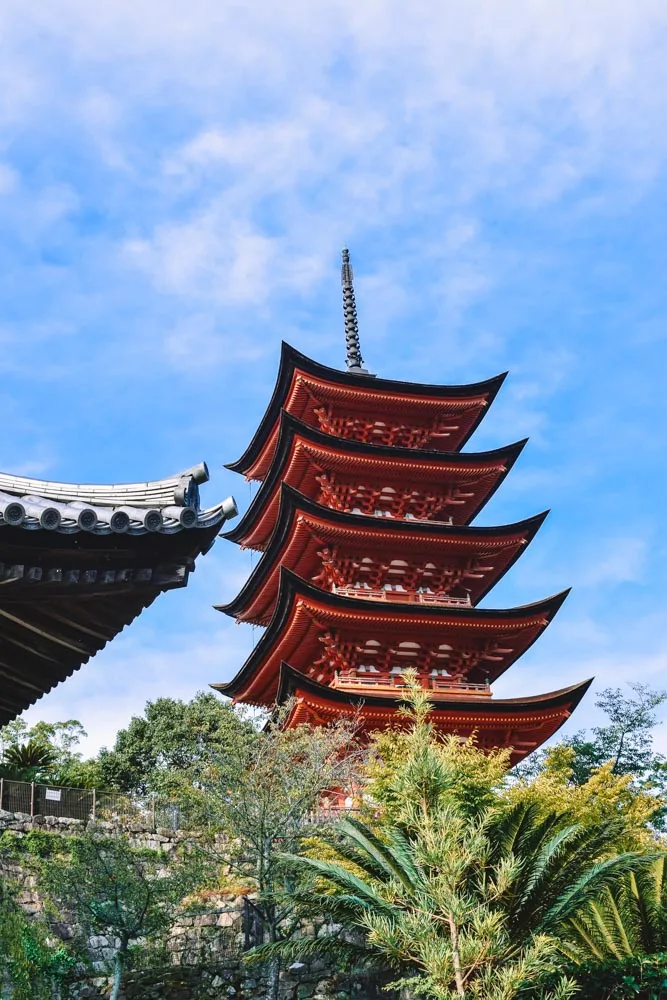
The five story pagoda in Miyajima Island
Day 9: Travel to Osaka
Now that you’ve hit the highlights of Hiroshima, it’s time to move onto Osaka.
The best way to get there is by taking the Hello Kitty Bullet Train. As the name suggests, the train is completely themed after Japan’s beloved fictional character, Hello Kitty.
The train departs from Hiroshima just after 08:00, which might be a little early for some. But if you’re only taking a 2 week trip to Japan, the early morning call time is worth it!
The best part of all is that this train ride is included in your Japan Rail Pass.
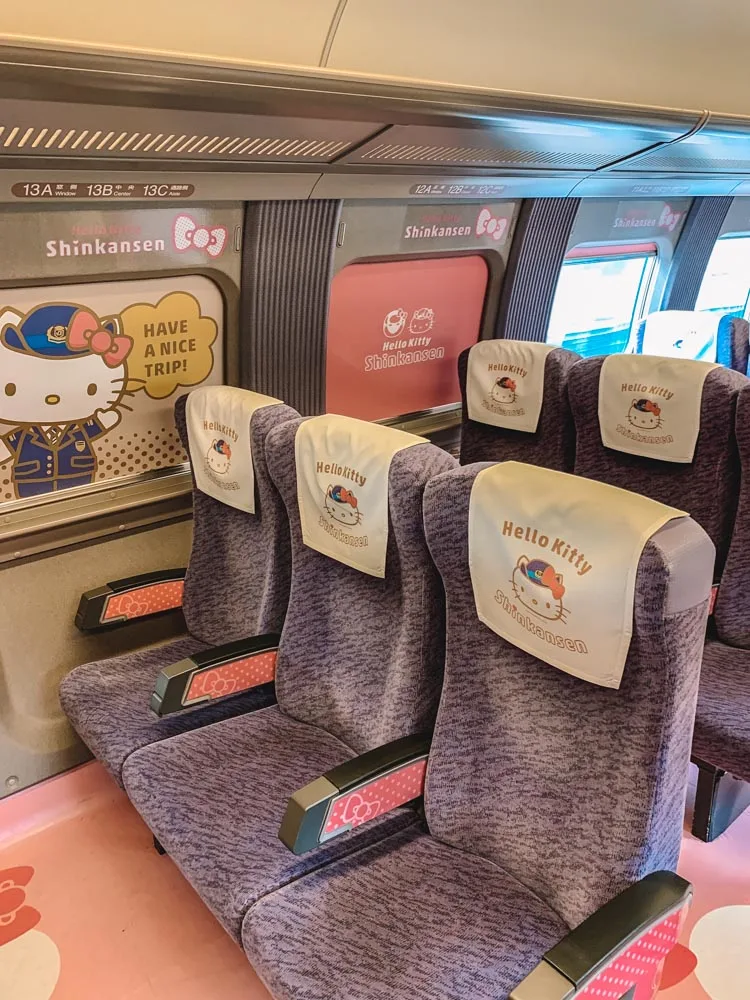
The seats on the Hello Kitty Shinkansen train from Hiroshima to Osaka
The total travel time from Hiroshima to Osaka is about three hours, but I suggest breaking up the journey at Himeji.
Visit Himeji Castle, a hilltop Japanese castle complex. The castle is a bit bare inside, but the views it offers from the top are absolutely spectacular.
It’s also a great place to visit to see authentic, preserved Japanese architecture. You can walk to the castle from the train station, so it’s a really easy stop to make along your route.
All Japan train stations have lockers where you can leave your bags on occasions like this, if you’re doing a stop along the journey before checking into your next hotel.
If you want to see more of Himeji beyond the castle, you can book a private customised tour with licensed guide like this one, to properly make the most of your time in Himeji.
Click here to book your Himeji private customised tour with local guide!
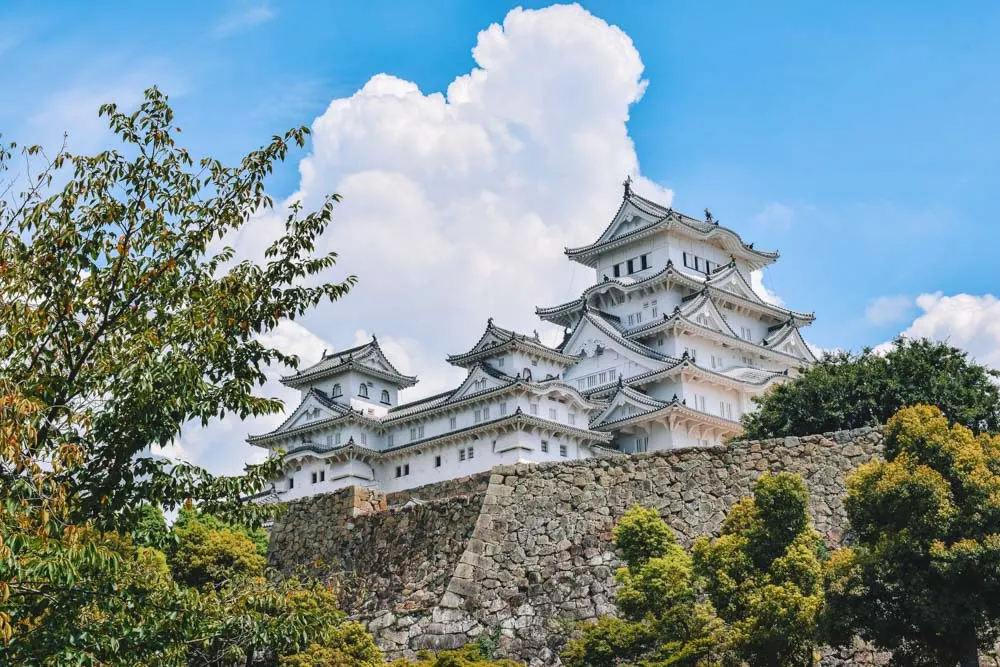
The outside of Himeji Castle

The view from the top of Himeji Castle
After you arrive in Osaka you’ll have a lot of fun attractions on offer – seeing as the city is the second-largest metropolis after Tokyo.
If you arrive early enough, you can visit the tallest skyscraper in Osaka for some pretty epic Japan photos.
Wondering where to stay in Osaka? We stayed at Hotel Monterey La Souer Osaka. The hotel was very conveniently located close to Osaka castle, and next to a train station for public transport.
Click here to see the latest prices and availability at Hotel Monterey La Souer Osaka!
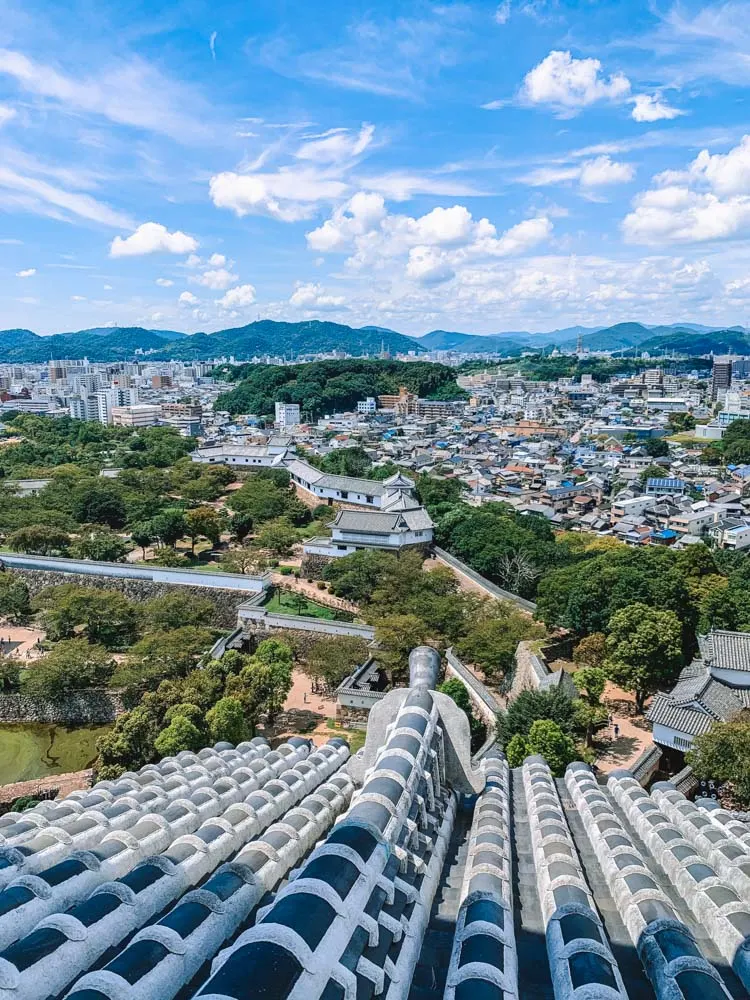
The view from the top of Himeji Castle
Day 10: Day trip to Nara
On day ten of your two week trip to Japan, take a day trip to the deer-filled city of Nara.
This area is famous for its tame reindeer and beautiful temples. Using your JR Pass, you’ll get from Osaka to Nara in about 50 minutes.
Once you arrive, you’ll be able to walk to several attractions from the train station.
First up, visit the Kofukuji five-storey pagoda. This large Buddhist temple is a fascinating historical tower that was constructed using wood.
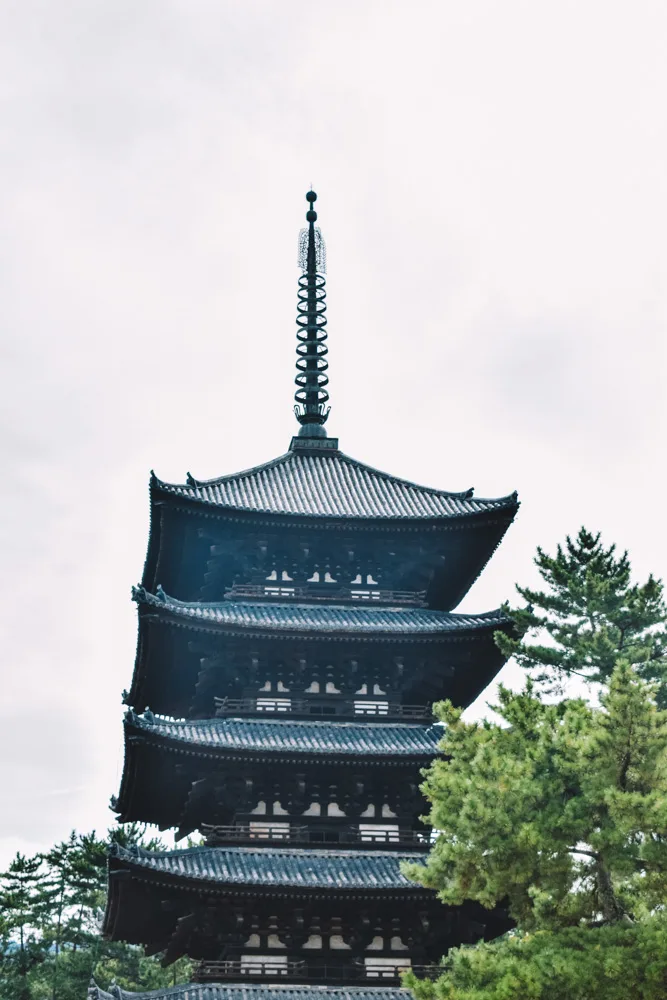
Kofukuji Five-Storied Pagoda in Nara, Japan
Next, see the Todaiji temple. Inside the complex, you’ll find numerous huge Buddha statues – they’re pretty impressive!
I was feeling pretty templed out by the time I arrived here and almost didn’t go inside, but I’m glad I did! This building stands out for its sheer size and beautiful statues.
The Kasuga-taisha temple is another beautiful shrine filled with lots of lanterns.
Even if you make your own way to Nara from Osaka, you can still join a cultural tour once you reach Nara, that way you’re sure you’re hitting all the must-see spots, with a local guide to tell you about them too!
Click here to book your cultural tour of Nara!

Admiring the giant statues inside Todaiji temple in Nara, Japan
Last but not least, wander around Nara Park and see the wild reindeer that roam freely. Street vendors sell deer crackers, which you can purchase to feed the deer.
The deer in Nara are very used to being fed and having tourists around, but you should still be careful as they are still wild animals.
| READ MORE: NARA DAY TRIP GUIDE |
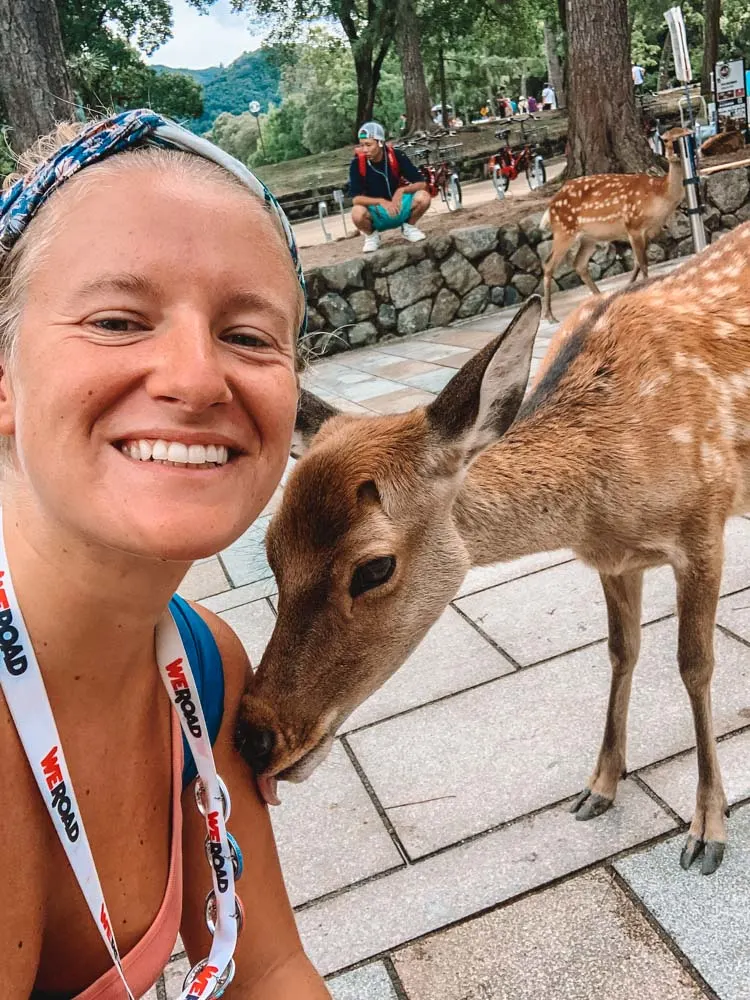
Trying to befriend one of the deer in Nara
Day 11: Explore Osaka
Spend your first full day in Osaka exploring the city.
First up head to Osaka Castle – the city’s most famous attraction. The castle is opulent from the inside out. There are lots of things to see and do, so make sure you wear your walking shoes when you visit.
The castle itself is a stunning sight. It rises high up and provides commanding views of the Osaka skyline. Osaka Castle Park covers about two square kilometres and offers plenty of green space.
The Osaka Museum is a history museum that makes a nice add-on to a castle visit. It’s a great place to get a glimpse of the history and culture of Japan.
If you want to make sure you visit all the main sights in Osaka, book yourself a full-day private guided walking tour, so that you’ll have a licensed guide all for yourself to show you all the best spots!
Click here to book your Osaka full-day private guided walking tour!
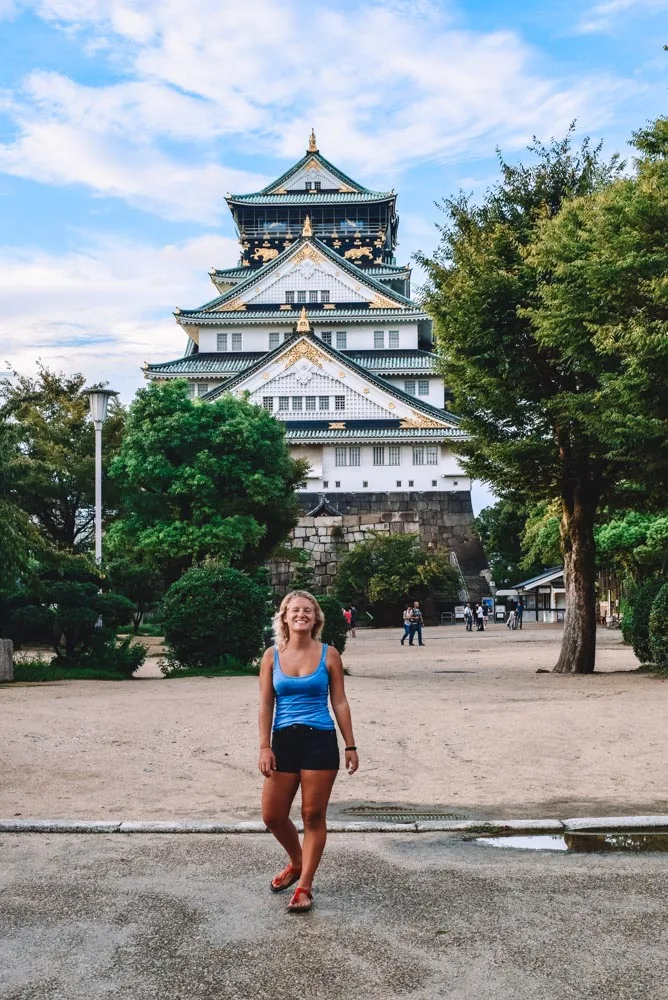
Exploring Osaka castle
After you’ve spent a few hours exploring the castle, make your way to Dotonbori Street. This is a very trendy area of Osaka that has lots of street food and shopping options.
Osaka is Japan’s food capital, and Dotonbori Street is the best place to indulge in the city’s cuisine. You’ll find street food everywhere. There are also plenty of restaurants and bars.
Most places have their own unique and colourful advertising signs. Dotonbori is also a great place to go out at night. It’s a spot in the city that’s popular with both locals and tourists alike.
There are so many places to eat at in Dotonbori that it’s hard to choose the right one. Avoid the tourist traps, and join an Osaka food tour with a local, to ensure you eat at all the best spots!
Click here to book your Osaka food tour!

Dotonbori neighbourhood in Osaka
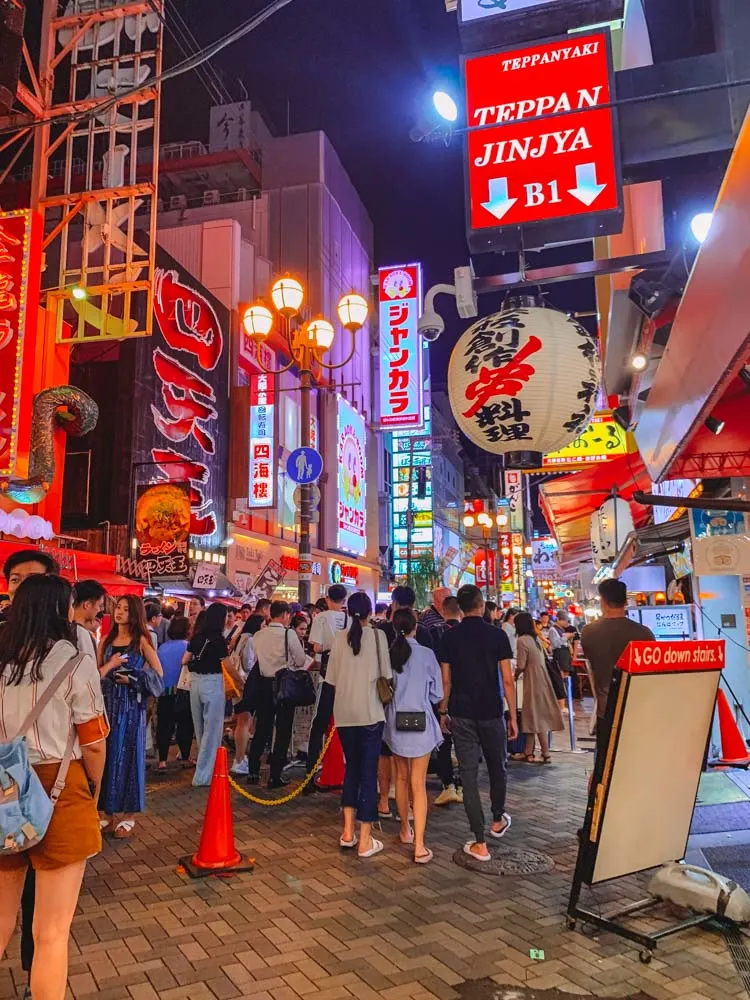
Exploring the street food in the Dotonbori neighbourhood of Osaka
Day 12: Travel back to Tokyo
Now that your Japan two-week itinerary is in its final stages, it’s a good idea to head back to Tokyo. Take the early morning train and make a stop at Mount Fuji if you feel like breaking up the trip.
Mount Fuji is an active volcano about 100 kilometres southwest of Tokyo. it’s the country’s tallest peak and the country’s most famous mountain.
When you arrive back in Tokyo, have lunch at the Ameyoko/Americaya street markets.
This is a typical Japanese food market and a local gem, and it’s packed with delightful food stalls. You’ll find some of the best street food in Tokyo here.
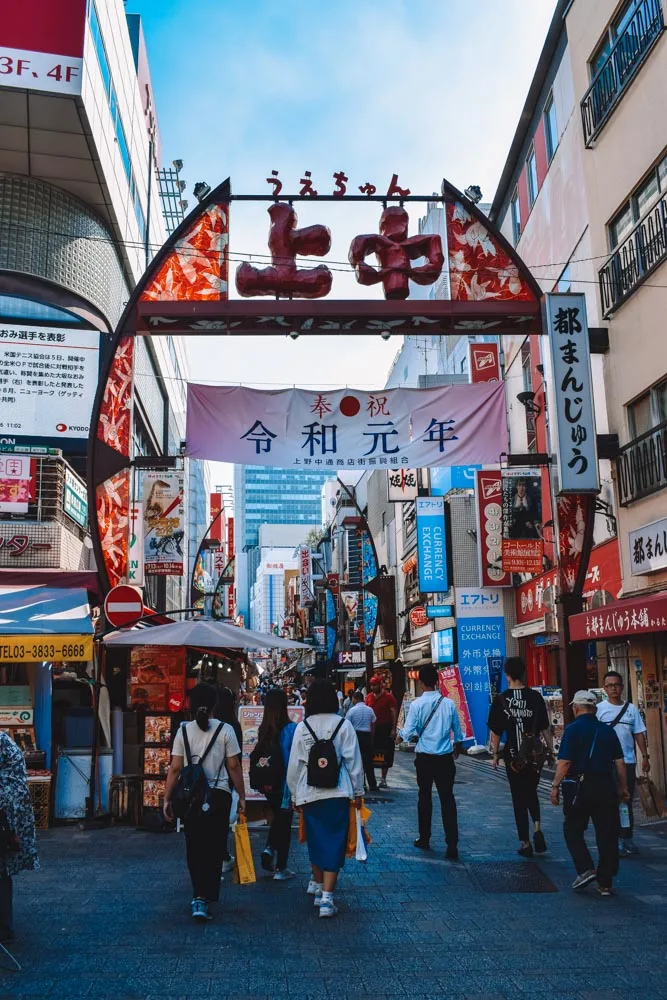
The bustling and colourful street of Ameyoko in Tokyo
Nearby, you’ll find Tokyo’s electronics district – Akihabara.
If you’re into comics, anime, or video games, you’ll find the best of Japanese electronic relators here. This place is manga central (a comic genre which is huge in Japan).
Take some time to explore this buzzing district. Besides electronic shops, there are also lots of really cool stores and cafes devoted to anime and manga.
For a young Dragon Ball and One Piece lover like me (any other fans reading this?) visiting Akihabara was loads of fun.
All the shops we visited sold either comic books, video games, and all sorts of toys from my favourite childhood cartoons.
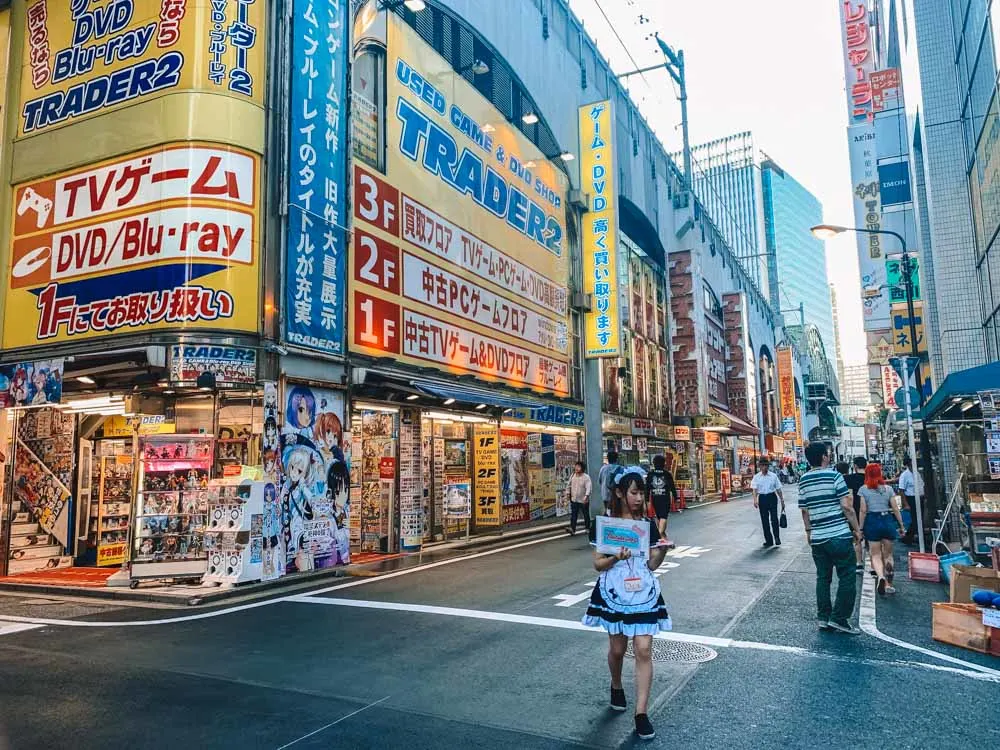
Exploring Akihabara in Tokyo
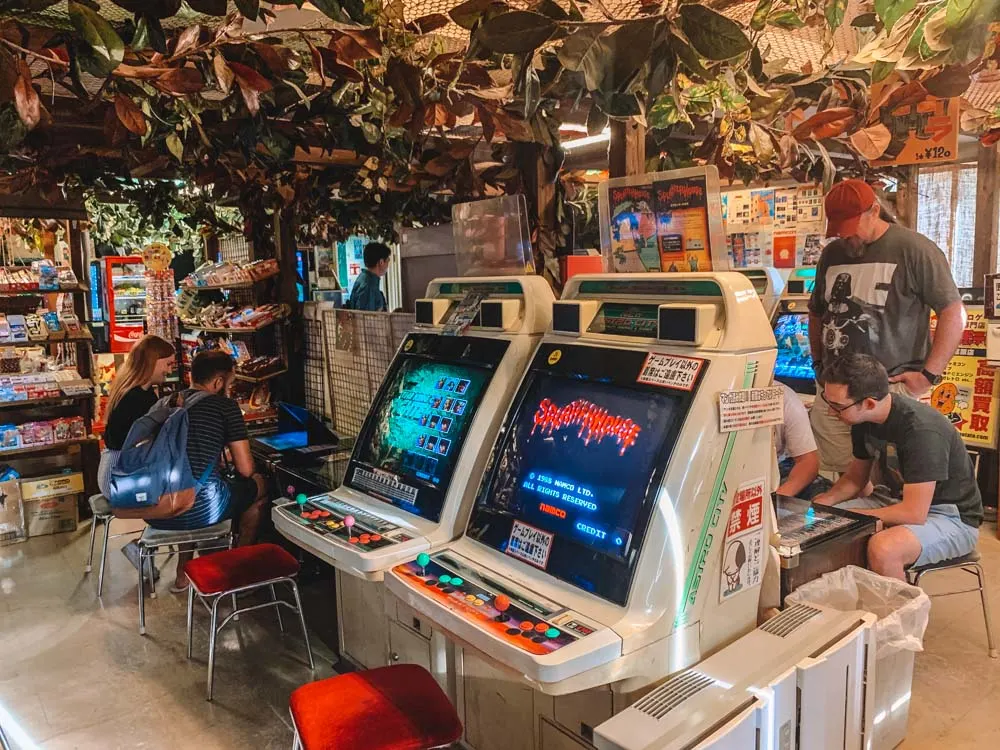
The top floor of Super Potato where you can play with vintage videogames
Day 13: Tokyo
Now that you’re on the last full day of your Japan vacation itinerary, you’ll want to do as much exploring as possible.
Visit TeamLab Borderless Museum first thing in the morning. This attraction is very popular, so it’s best to get there right when they open at 10:00 and book your tickets in advance.
This interactive art museum brings art to life in a mesmerising way. Each room has something new to offer; you’ll feel like you’re in another world!
Click here to book your ticket at TeamLab Borderless!
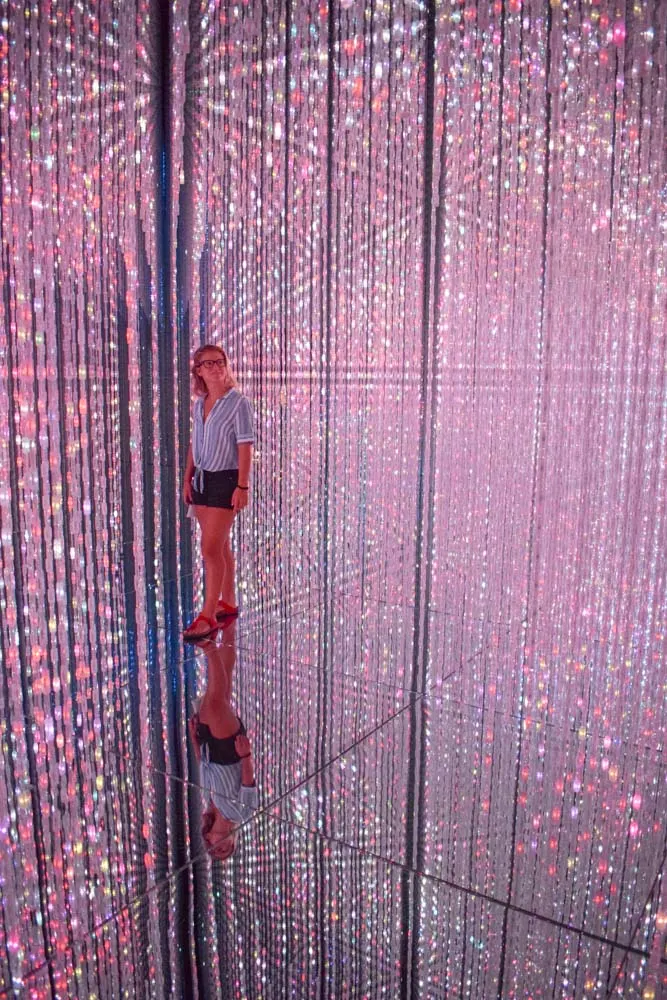
One of my favourite rooms at the Teamlab Borderless in Tokyo
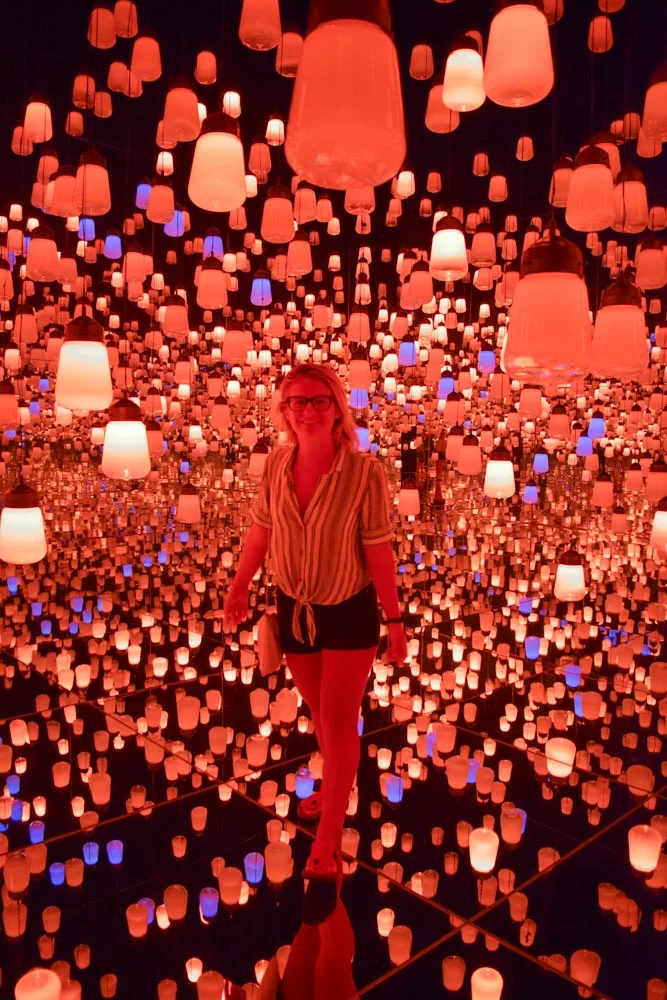
The lantern room at Teamlab Borderless in Tokyo
After you’ve finished at the museum head over to Tsukiji Fish Market for lunch. This is one of the largest seafood markets in the world, and one of the most famous attractions in Tokyo.
This is not only an area where local restaurant owners go to buy fish, but there are also lots of street food stalls and restaurants to choose from where you can eat.
Indulge in sushi, fresh crab, oysters, or whatever else you’re craving that comes from the sea. We ate at a place called Sushizanmai, and it was one of the best sushis I’ve ever had.
If you don’t fancy going for a full sit-down meal, you can also join a Tsukiji Market food & drink walking tour, and have a local take you to all the best dining spots in the market!
Click here to book your Tsukiji Market food & drink walking tour!
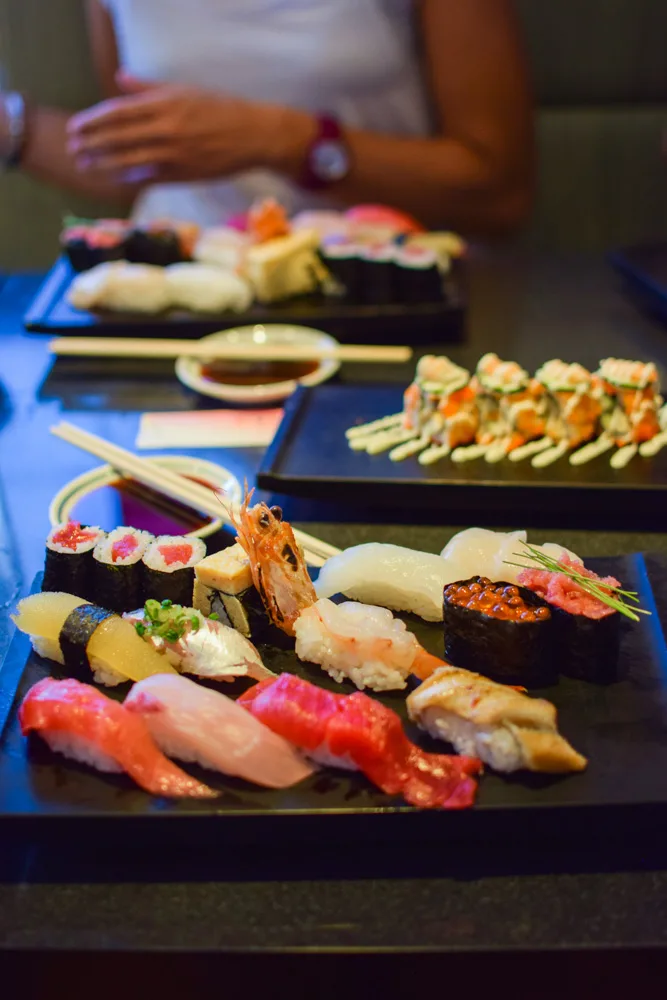
Sushi from Tsukiji fish market in Tokyo
Day 14: Tokyo & end of trip
Leaving a country as beautiful as Japan might be hard. But if you’ve followed this Japan travel blog you will have seen so many great areas of the country that you’ll feel enriched and happy with your trip.
Try to get an evening flight so that you have time to do some last minute exploring. You should explore the Asakusa neighbourhood and get a feel for older Tokyo.
You can tour the area on a rickshaw ride for a unique perspective. You’ll pass lots of iconic sits and see the area through the eyes of a local.
While you’re in the area, make sure to visit the Senso-ji temple. This ancient Buddhist temple was completed in 645, making it Tokyo’s oldest temple. It’s a beautiful piece of Japanese culture and a must-see when you visit Tokyo.
Click here to book your rickshaw tour of Asakusa!

Senso-ji temple in Asakusa, Tokyo
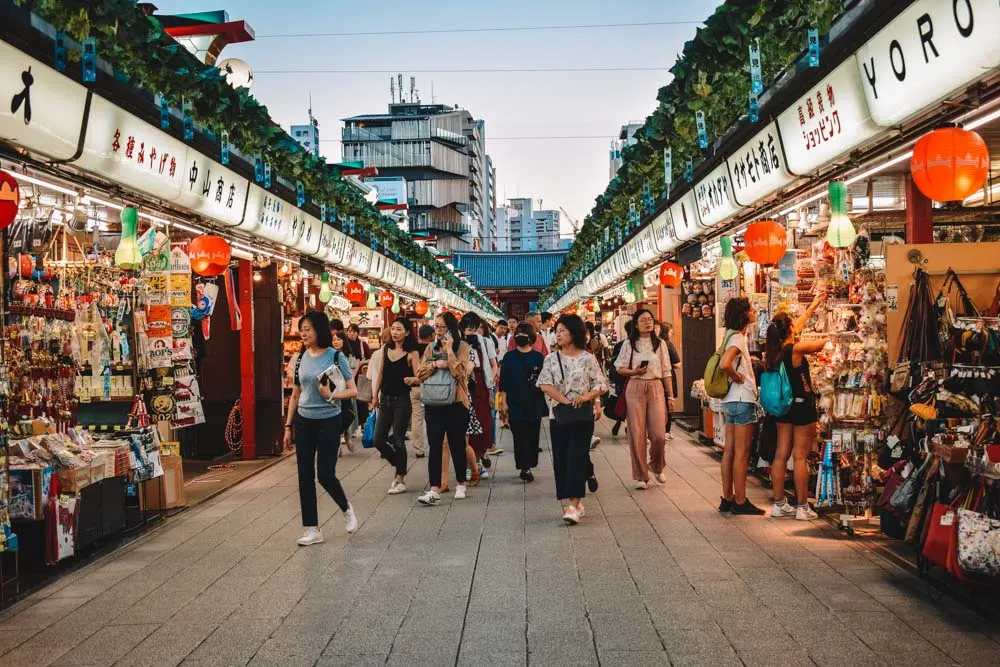
The road of cute shops leading up to Senso-ji temple in Asakusa, Tokyo
Conclusion of your 2 weeks in Japan itinerary
As you can tell from this guide, exploring Japan in two weeks is totally do-able. The size of the country and its accessible transportation options are very conducive to tourism.
The best thing about Japan is that this country has a little bit of everything. From chaotic cities to tranquil islands and scenic parks, or from ancient history to modern techno and manga scene, there’s so much to discover.
For this reason, I’ve made sure to include big cities as well as areas that are off-the-beaten-path.
Whether you’re travelling alone, with family, friends or kids, this two weeks Japan itinerary is perfect for every type of traveller. This is a country that will amaze you at every corner!
Enjoyed reading my Japan 14-day itinerary? Pin it!








